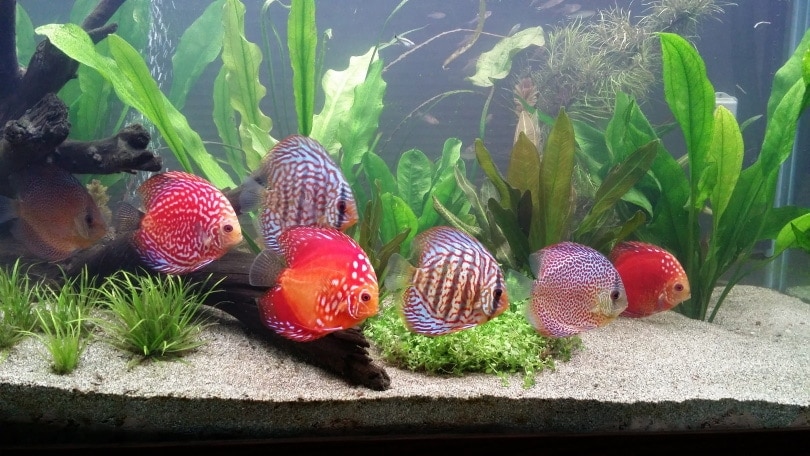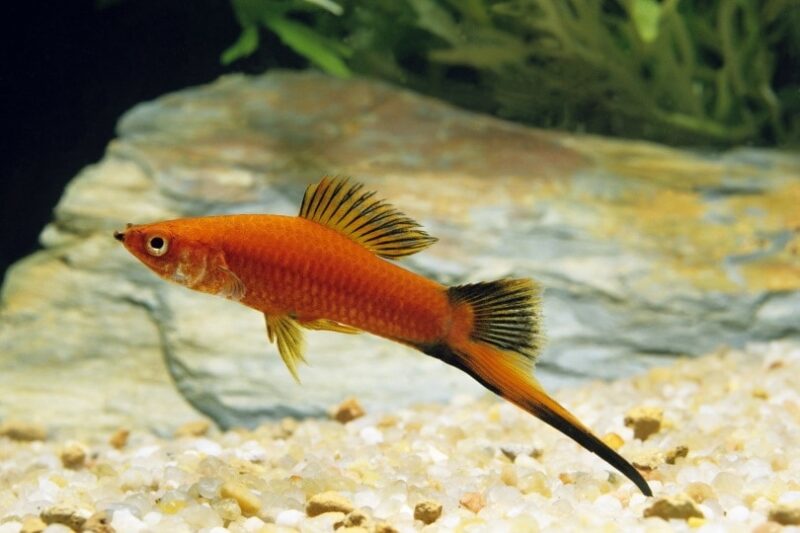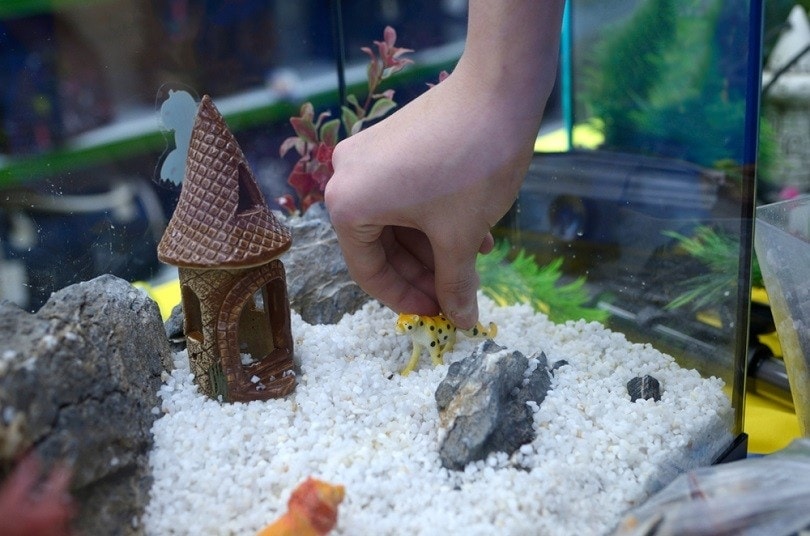Molly Fish: Pictures, Size, Care, Tank Setup, & More
Updated on
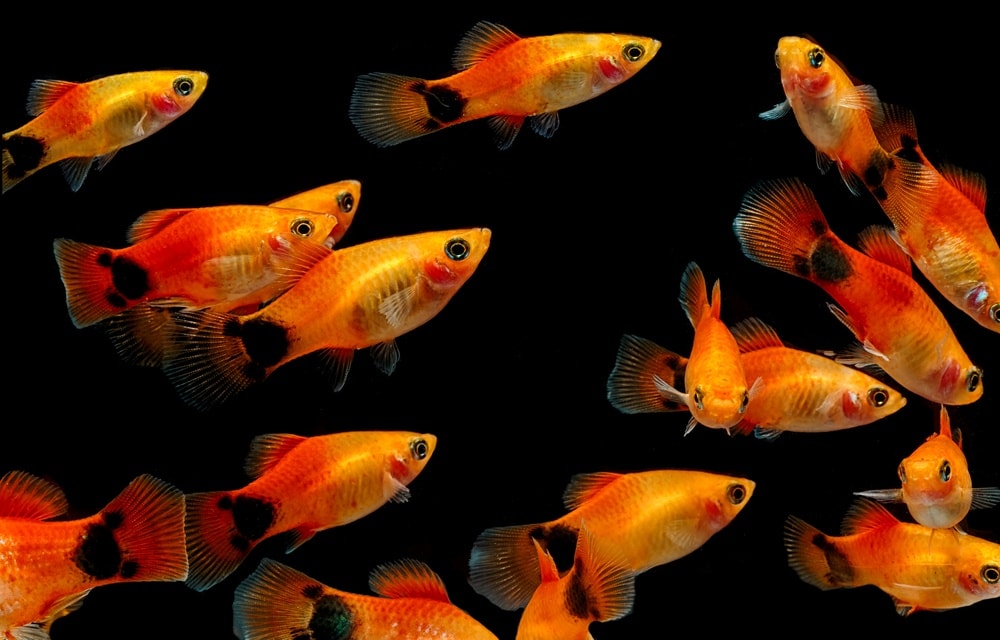
Click to Skip Ahead
Mollies are small live-bearing fish that are often kept in tropical aquariums. You will often find that Mollies are sold as beginner-friendly fish since they are relatively easy to maintain. They make great pets and add a dash of color to many aquariums while being peaceful and social. Potential Molly fish owners are encouraged to learn and understand this species of fish, as this will allow you to care for them properly throughout their lives.
With proper care, most Molly fish can live for 3 to 5 years and thrive in various types of tank setups. With this in mind, we have created an in-depth guide on caring for these brilliant freshwater fish.
Quick Facts About Molly Fish
| Species Name: | Poecilia sphenops |
| Family: | Poeciliidae |
| Care Level: | Beginner |
| Temperature: | 75° F to 80° F |
| Temperament: | Peaceful, social |
| Color Form: | Black, orange, red, silver, white, bronze, yellow |
| Lifespan: | 3 to 5 years |
| Size: | 2 to 5 inches |
| Diet: | Omnivore |
| Minimum Tank Size: | 20 gallons |
| Tank Set-Up: | Heated, filtered, live plants |
| Compatibility: | Other live-bearing fish |
Molly Fish Overview
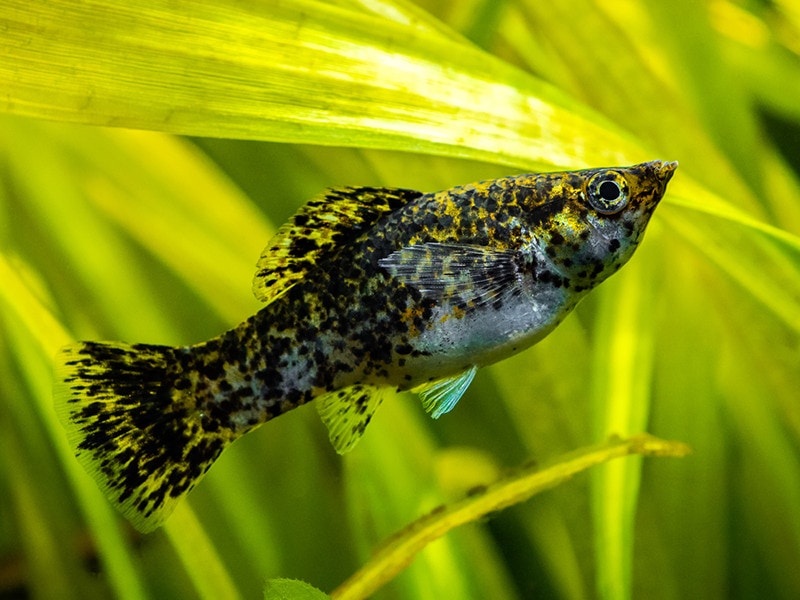
Mollies are live-bearing fish from the Poecilia genus. They are native to the Southern United States to the Yucatan peninsula of Mexico. There they inhabit tropical freshwater environments such as streams, rivers, mangroves, and lagoons. However, some wild Molly fish can also tolerate living in waters with a higher salinity content. These types of waters are described as brackish conditions, having more salt than freshwater, but not as much as a marine environment.
There are over 30 different species of Molly fish, with the most popular one being the Poecilia sphenops or short-finned Molly fish. Wild Molly fish usually have a dull silverish coloration, but captive specimens have been bred to develop many different varieties. As livebearers, Mollies do not lay eggs to reproduce. Instead, they give live birth to fry that they do not raise. Most Mollies are omnivores and eat this type of diet in both the wild and in captivity.
How Much Do Molly Fish Cost?
The average price of a Molly fish is between $2 to $25 depending on its rarity and size. The short-finned or common Molly fish is usually lower in price since they are widely available. When it comes to purchasing a Molly fish, pet stores are usually the first-place people choose. Pet stores generally don’t sell Mollys for more than a couple of dollars. However, you can also purchase Molly fish from breeders.
Typical Behavior & Temperament
Molly fish are described as having a peaceful temperament while being quite social. Most Molly fish aren’t aggressive or fin nippers, although there are a few that might be. Mollies prefer to keep to themselves and enjoy interacting with each other. When housed in the appropriate tank setup with other peaceful fish, Mollies enjoy swimming around the tank, foraging for food, and exploring plants and décor. If your Molly is spending most of their time hiding or bottom-sitting, these are generally signs that your Molly fish can be stressed or sick.
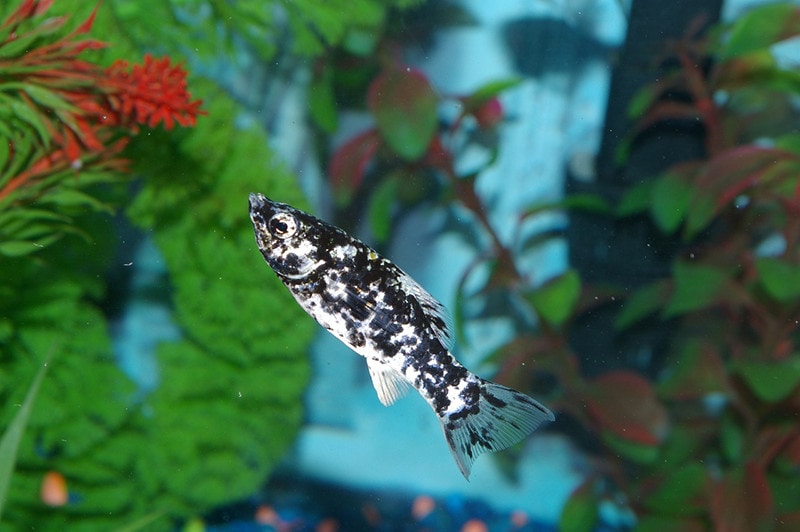
Appearance & Varieties
There are many different varieties and species of Molly fish and each one has specific fin types, markings, shapes, and colors. The short-finned Molly is the most common Molly fish that are available as pets. Several other species such as the sailfin (P. latipinna), Southern (P. vivipara), and the Yucatan lyretail (P. velifera) Mollies are also kept as pets.
You can find Molly fish in colors like orange, black, silver, white, and bronze. Dalmatian spots, solid, and multi-colored are common patterns and markings seen in these aquarium fish. Furthermore, Molly fish grow to around 2.5 to 5 inches in size depending on their species. However, some small species of Molly are under 2 inches, known as the Dwarf Molly fish.
Mollies generally have short or long fins, including a tail and dorsal fin. The Sailfin Molly has a much larger dorsal fin in comparison to the Short-finned Molly. Other varieties of Mollies can also have a lyre tail, which looks quite striking in aquariums. Although Mollies typically have a flattened body and triangular head, the Balloon Molly has a more compact body shape as their name suggests. Balloon Mollies are also slightly smaller than some other varieties at around 2 to 2.5 inches in size.
How to Take Care of Molly Fish
Habitat, Tank Conditions & Setup
Tank Size
The most common Mollies like the Short-finned, Balloon, and Sailfin Molly should have a minimum tank size of 20 gallons. You generally want to avoid keeping Mollies in bowls, vases, and other small aquaria. A larger tank is always better for these fish and allows them to swim and display their natural behaviors. A larger tank will also make it easier to keep these fish in groups since they are social fish.
Water Quality & Conditions
Mollies should be raised as freshwater fish, even though they can tolerate a higher salinity content in their water. This is especially important if you keep Mollies in a communal tank with non-brackish water fish. As tropical fish, Mollies require a heater in their aquarium. The heater should be set at a temperature between 75 to 80 degrees Fahrenheit since this is within their ideal temperature range. A pH range of 7.5 to 8.5 is acceptable for Mollies and they tolerate hard water better than soft water.
As with many other aquarium fish, their tank should have 0 ppm (parts per million) ammonia and nitrite levels. Mollies can tolerate nitrate levels up to 25 ppm before showing issues. These water conditions can be achieved by using a filter and allowing the tank to undergo the nitrogen cycle.
Substrate
Mollies aren’t picky about the substrate in their aquarium. You can choose between sandy, gravel, rock, or pebble-like substrates for these fish. However, you want to avoid brightly colored gravels that have dyes or paints. This is because they can leach colors in the aquarium over time, which may start poisoning your Mollies and affecting the water quality. It’s best to stick to natural substrates that your Molly may experience in the wild.
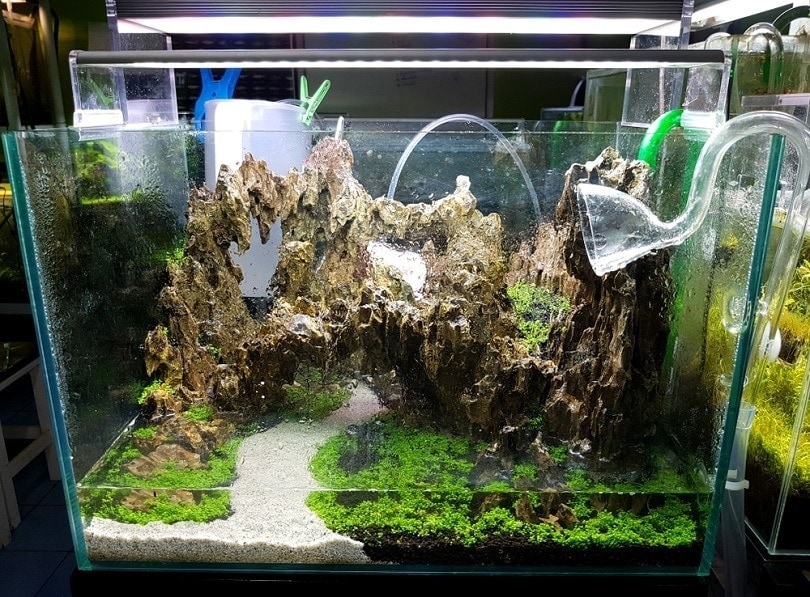
Plants
Although live plants are optional for Molly fish tanks, they are beneficial. Live plants can help improve the water quality while offering your Mollies a natural environment. Live plants also shelter your Molly fish and protect their fry from being eaten.
Lighting
Unless your Molly fish tank is receiving natural light without direct sunlight, artificial lighting is necessary. The lighting shouldn’t be overly bright, but enough to illuminate the aquarium and aid in live plant growth. Any lighting should be turned on during the day for 6 to 10 hours and turned off at night. Mollies need to rest in complete darkness and don’t require a night light.
Filtration
All Molly fish tanks should be equipped with a filter. There is a wide range of filters to choose from, although sponge filters are an affordable and effective filtration system for Mollies. Filters will keep the water from becoming stagnant and contain beneficial bacteria that help with the overall water quality.
Are Molly Fish Good Tank Mates?
Molly fish should ideally be kept with the same species in groups of six or more. They do best in groups with more females than males to prevent breeding-related stress. As peaceful fish, Mollies can also be kept in community aquariums. They are rarely aggressive, unlikely to be fin nippers, and generally keep to themselves.
If the provided tank is large enough, groups of Mollies can be kept with compatible tank mates. These tank mates include other peaceful live-bearing fish such as Guppies, Platys, and Swordtails. With plenty of hiding places, you can also keep Mollies with freshwater shrimp and snails. The tank size should always be increased if you plan to add more fish to the aquarium. You should never pair Mollies with large or aggressive fish like Cichlids, Oscars, and Bettas.
You also shouldn’t keep them with temperate water fish like koi or goldfish. These types of fish have different tank sizes and water condition requirements that make them incompatible tank mates for Mollies.
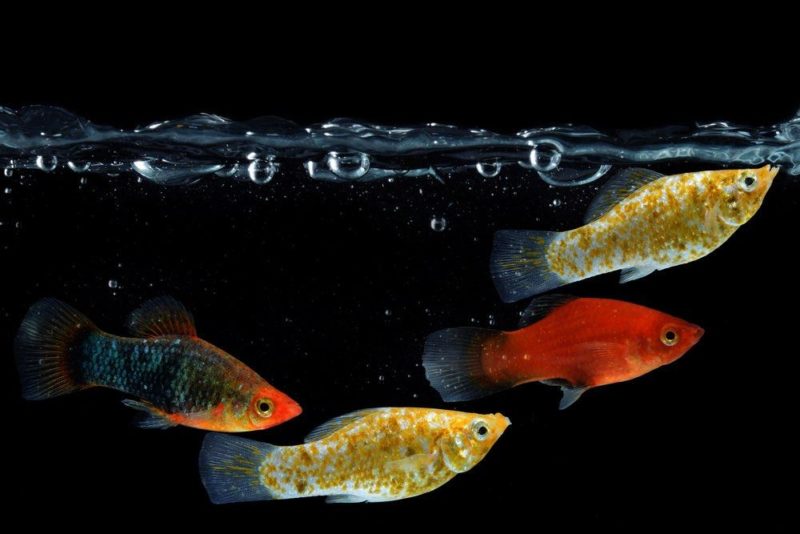
What to Feed Your Molly Fish
Mollies are naturally omnivorous and eat both plant and animal matter in the wild. A wild Molly’s diet consists of small crustaceans, insects, krill, worms, algae, and plants. In captivity, Mollies should eat commercial pelleted food formulated for livebearers. Their diet can be supplemented with frozen or live foods like baby brine shrimp and daphnia. Mollies also enjoy eating green algae and algae wafers formulated for bottom-dwelling fish.
Keeping Your Molly Fish Healthy
Below are several tips that can help keep your Molly fish healthy.
- Tank: Ensure that your Mollies tank is above the minimum size and is equipped with a heater and filter.
- Water pH: Mollies don’t tolerate fluctuations in the water pH. Most Mollies do best with neutral to slightly acidic waters. Any fluctuations in the pH can be stressful for your Molly fish, which may make them susceptible to disease.
- Temperature: Mollies prefer being in a heated aquarium that replicates the tropical conditions they experience in the wild. A water temperature below 70 degrees Fahrenheit is too cold for Mollies.
- Tank mates: Housing your Mollies with incompatible tank mates can cause them unnecessary stress. It is recommended to only house Mollies with other peaceful, small, and tropical fish.
Breeding
Mollies are live-bearing fish that do not lay eggs. They reproduce by internal fertilization and the female Molly will be pregnant for up to 60 days. A breeding pair of male and female Molly fish are ready to breed as soon as 6 months. Pregnant Mollies can give live birth to around 40 to 100 fry. If the fry has no place to hide or avoid predators, they are at risk of being eaten. To prevent this, you can create a breeding tank in which the Mollies can breed and reproduce. This tank should have plenty of hiding places from plants or netting. Some great plants that Molly fry can hide in are java moss and hornwort.
Are Molly Fish Suitable for Your Aquarium?
You have many different varieties of Mollies to choose from, including ones with unique markings and fascinating colors. When it comes to deciding whether your aquarium is right for Mollies, you will need to consider their ideal living requirements. Mollies thrive in spacious planted aquariums with a heater and filter. Although they can tolerate brackish conditions, a freshwater aquarium is best.
So, if you have a tropical aquarium over 20 gallons in size that is filtered, Mollies can make a great addition to your aquarium.
Featured Image Credit: Praisaeng, Shutterstock


